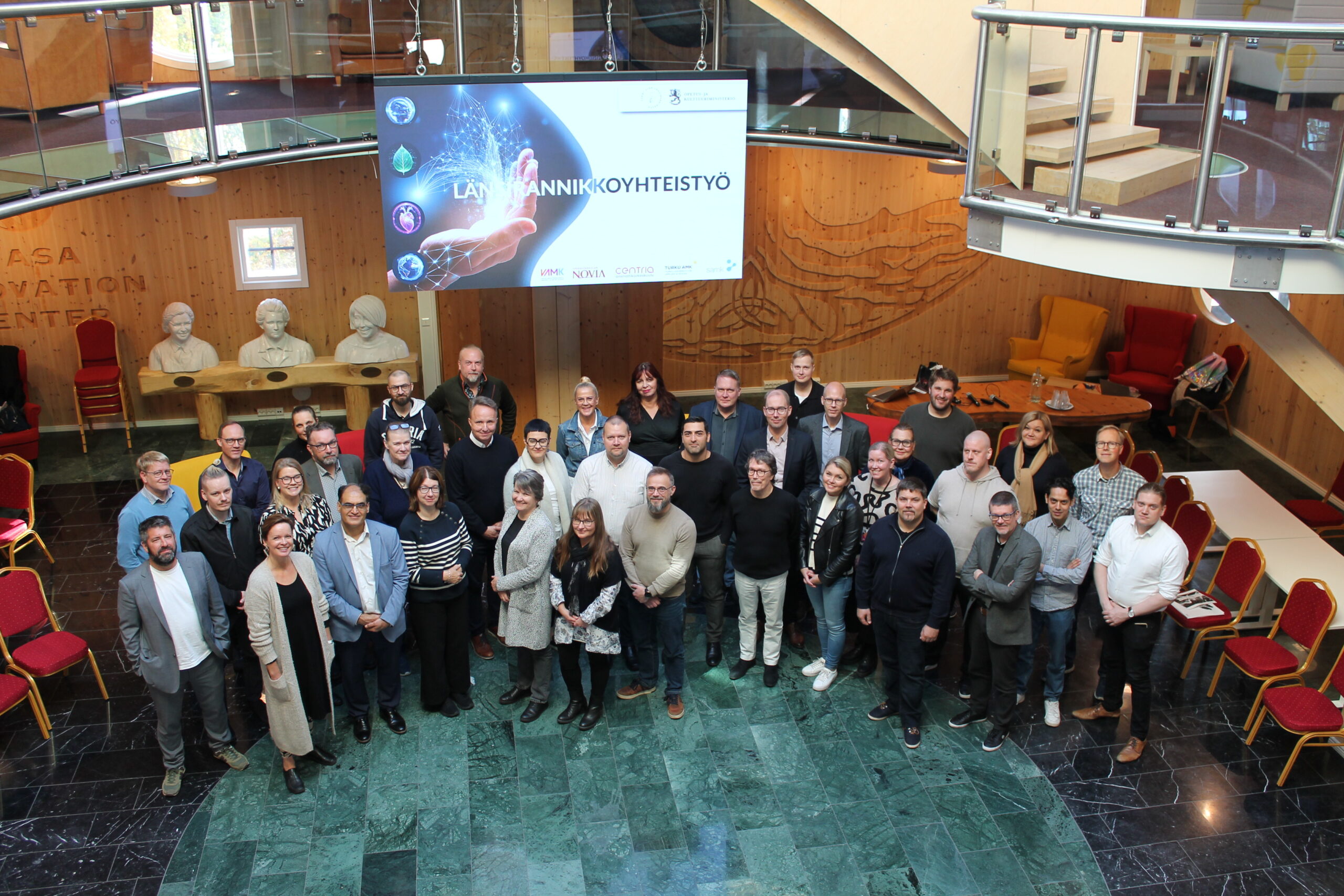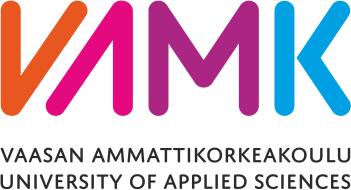
West Coast Workshop geared towards sustainable growth
The West Coast Workshop 2024 brought together the region’s leading companies, SMEs, research organisations and universities in early October. The two-day event provided participants with the opportunity to discuss new opportunities for cooperation, develop innovations and share their expertise across sectors.
The West Coast Workshop 2024 brought together the region’s leading companies, SMEs, research organisations and universities to develop cooperation and innovation. The two-day event provided participants with the opportunity to delve deeper into green transition, digitalisation and sustainability – topics that are crucial to strengthening the competitiveness and vitality of the West Coast.
The event was opened by Marja-Riitta Vest, Director of RDI at Vaasa University of Applied Sciences (VAMK), who highlighted the importance of collaboration between research, education and business in generating new business opportunities and innovations. Vest said that the strong ecosystem on the West Coast supports sustainable development and the strengthening of the region’s economy, laying the foundations for long-term growth and competitiveness.
The first workshop focused on roadmaps for driver companies and the opportunities they offer for SMEs and research organisations. Representatives from Wärtsilä, ABB, Danfoss Drives, Mirka and Kempower presented their companies’ strategic priorities and future developments. In particular, the discussions highlighted the opportunities for the SME sector to use the know-how and infrastructure of the driving companies to develop new technologies and solutions.
At the same time, another working group focused on the transformation of the welfare sector and the role of universities as drivers of development. Hanna Kaisa-Pernaa (Director, Social and Health Sector, VAMK) and Vest led the discussion on how the transformation of the welfare sector requires increasingly close cooperation between universities, welfare regions and technology companies. Representatives of the Ostrobothnian Welfare Region and Smart Society platform leader Riku Niemistö, Senior Lecturer, gave an overview of ongoing cooperation projects where the potential of digitalisation and artificial intelligence is seen as key in the development of welfare services.
Mika Niskanen, Senior Expert at Business Finland, concluded the day by presenting funding opportunities for companies and research organisations to support the implementation of innovations and their scaling up to international markets. Based on the discussions during the first day, participants were divided into groups to further develop new areas of cooperation under the leadership of the driving companies.
The second day of the workshop took place at the Wasa Innovation Center, where the focus was on project planning and thematic grouping. The working groups summarised the key findings of the first day and continued to design projects to implement the roadmaps. The thematic groups focused on battery and circular economy solutions, sustainable water management, logistics and security of supply, robotics and digital manufacturing, and hydrogen technology. The development of these sectors is key for the West Coast, where companies have long been investing in low-carbon energy, industrial digitalisation and international competitiveness.
During the day, Business Finland’s Health360 Finland programme was presented remotely. Programme leader Tarja Enala highlighted the potential of digitalisation of health technology and wellness services in Finnish healthcare and its impact on the transformation of the sector.
After intensive work in the thematic groups, the participants summarised their findings and drew up preliminary plans for further action. Based on these plans, concrete steps were agreed to take the projects forward in cooperation between research and business. The workshop ended with a joint GoWestCoast dance exercise, which provided a break from the intense work and an opportunity for participants to network in a relaxed atmosphere.
The West Coast – The Driving Force of Finland’s Economy and a Center of Innovation
The west coast is a key region for Finland’s industry and exports, with a significant impact on the national economy. Its importance for Finland’s competitiveness is particularly evident in the fact that it generates about one-fifth of the country’s GDP and serves as home to many export-driven industrial sectors. The concentration of industrial companies in the west coast is no coincidence—it is the result of long-term infrastructure development, a high level of expertise, and a strategic location.
The ports of Vaasa, Turku, Pori, and Kokkola together form a significant logistical network, enabling efficient goods exports to both European and global markets. Approximately 40% of the total value of Finland’s goods exports passes through these west coast ports, highlighting their critical role in international trade (Ostrobothnia Chamber of Commerce, 2019). The region’s connections with Scandinavia are particularly strong, and cooperation with Swedish and Norwegian industries supports the growth and internationalization of Finnish companies. For example, the year-round maritime route between Vaasa and Umeå links Finnish and Swedish transport corridors, enhancing the area’s appeal and accessibility (Pohjanmaan kauppakamari, 2019).
The global demand for high value-added products, such as energy technology and electrification solutions, is increasing, and the west coast is at the heart of this development. The region hosts major industrial clusters, such as the Vaasa energy cluster—the largest in the Nordics—and the inorganic chemical industry cluster in Kokkola. These clusters make effective use of the logistical connections provided by the ports, strengthening Finland’s position in international markets (Pohjanmaan kauppakamari, 2019).
The west coast industry is not only locally important—it has a nationwide impact on Finland’s economy and employment. Every company and development initiative in the region strengthens Finland’s position as a forerunner in high technology and sustainable development.
Leading Companies and Future Development Trends
The west coast is home to several internationally significant companies that continuously invest in new technologies and sustainable solutions. For instance, Wärtsilä has opened a new Sustainable Technology Hub in Vaasa, which acts as a center for a global innovation ecosystem and promotes the development of low-emission energy solutions (Wärtsilä, 2024). Similarly, ABB’s Marine and Ports unit in Helsinki develops electrification and automation solutions for the maritime industry, such as the Azipod® propulsion system, which improves vessel fuel efficiency and energy performance (Comatec Group, 2018).
Energy and maritime industries are among the strongest sectors in the region, and their development is closely tied to emission reduction and improved resource efficiency. Wärtsilä’s investments in low-emission energy and ABB’s electrification and automation technologies are examples of how the west coast is driving forward innovations with global impact (Wärtsilä, 2024; Comatec Group, 2018).
The electrification of industry and adoption of sustainable energy are also key themes for local companies. For example, Danfoss is supplying hundreds of AC drives to Wärtsilä’s new Smart Technology Hub in Vaasa, demonstrating close collaboration between companies in the region and a shared commitment to sustainable development (Danfoss, 2024). Mirka, a surface finishing technology company, is investing in environmentally friendly products that support industrial sustainability.
These companies operate within a broader ecosystem where businesses, universities, and research institutions work closely together. This cooperation enables the development and adoption of new technologies and helps companies in the west coast remain competitive in international markets.
The Role of Competence and Education in Development
The strength of the region’s industry is not solely based on company investments but also on the high standard of higher education and research. The west coast hosts several universities of applied sciences—such as Vaasan ammattikorkeakoulu (VAMK), Turun AMK, Satakunnan AMK, Centria, and Novia—which offer practice-oriented education and actively contribute to developing the region’s knowledge base. Together, these institutions form a competence hub with focus areas in industry, energy, logistics, health and well-being, and security of supply. In the initial phase of cooperation, particular emphasis is placed on digital manufacturing technologies, robotics, and clean energy solutions (Vaasan ammattikorkeakoulu, 2024).
The growth of the technology industry requires a continuous influx of new professionals, with engineering and technology education playing a crucial role. Cooperation between educational institutions and companies is evident in initiatives where students participate early in RDI projects that develop practical solutions for industrial needs. For example, VAMK’s Smart Industry platform focuses on identifying and implementing actions that promote carbon neutrality in industry, leveraging digitalization to develop smart and green industry solutions (VAMK, 2024).
Universities of applied sciences do not only educate future professionals—they also actively participate in innovation development. VAMK’s Smart Industry platform illustrates how education and research can support corporate development work and accelerate the adoption of new technologies. The platform’s goals include exploring the possibilities of decentralized energy production in Ostrobothnia and developing new energy storage solutions and hydrogen technologies (VAMK, 2024). Furthermore, Åbo Akademi has established significant cooperation with west coast universities of applied sciences in the field of doctoral education, allowing RDI personnel to pursue doctoral studies organized by the university. This collaboration supports competence development particularly in applied, practice-oriented research (Åbo Akademi, 2024). Multidisciplinary cooperation ensures that companies in the region have access to the skilled workforce they need and that R&D activities respond to the current challenges of industry.
Future Outlook and Challenges
The west coast’s strong position in Finland’s economy is not guaranteed, and the region must continually adapt to changing market conditions and global trends. One of the most significant challenges is the green transition, which demands substantial investments and new innovations. Industrial electrification, circular economy solutions, and low-emission energy sources are key development areas for securing the region’s future competitiveness. For example, the Kainuu region has recognized the potential for energy-intensive industries to establish operations there, which requires optimization of both energy production and usage (Kainuun liitto, 2025).
Digitalization and automation also play a key role as industries aim to improve efficiency and reduce environmental impacts. Smart production processes, artificial intelligence, and robotics are transforming traditional industrial sectors and creating new business opportunities. This progress requires investments in research and development, as well as close cooperation between companies and educational institutions (Haaga-Helia ammattikorkeakoulu, 2023).
Access to skilled labor is another critical issue. The growth of the technology and industrial sectors demands a steady stream of new talent, and the development of education is a central part of the region’s long-term strategy. Implementing the green transition in Finland is estimated to require an additional 3,100–4,500 engineer work-years by 2030 (Engineers Finland, 2022). Attracting skilled workers to the region and developing educational pathways will ensure that the west coast remains competitive in the future.
Internationalization and strengthening export markets are also important goals. Finland’s global competitiveness depends on its ability to develop innovative products and services that meet international demand. Companies on the west coast are well-positioned for this, but they must continue to invest and innovate to stay ahead of the competition. For instance, in the Central Finland region, innovations related to materials technology have been identified as potential drivers of sustainable growth (Kuntaliitto, 2021).
References
Comatec Group. (2018, 17. elokuuta). ABB Marine. Haettu 21. helmikuuta 2025 osoitteesta https://www.comatec.fi/abb-marine/
Danfoss. (2024). Danfoss toimittaa satoja AC-taajuusmuuttajia Wärtsilän Smart Technology Hubiin. Haettu 21. helmikuuta 2025 osoitteesta https://www.danfoss.com/fi-fi/about-danfoss/news/danfoss-toimittaa-satoja-ac-taajuusmuuttajia-wartsilan-smart-technology-hubiin/
Engineers Finland. (2022, 4. maaliskuuta). Osaajapula uhkaa vihreän siirtymän toteutumista. Haettu 21. helmikuuta 2025 osoitteesta https://www.tek.fi/fi/uutiset-blogit/engineers-finland-osaajapula-uhkaa-vihrean-siirtyman-toteutumista
Haaga-Helia ammattikorkeakoulu. (2023, 27. maaliskuuta). Vihreä siirtymä ja digitalisaatio – Työkirja asiantuntijoille ja opettajille. Haettu 21. helmikuuta 2025 osoitteesta https://www.haaga-helia.fi/fi/ajankohtaista/artikkelit/vihrea-siirtyma-ja-digitalisaatio
Kainuun liitto. (2025, 6. helmikuuta). Energiaintensiivisen teollisuuden mahdollisuudet Kainuun maakunnassa. Haettu 21. helmikuuta 2025 osoitteesta https://kainuunliitto.fi/assets/uploads/2025/02/Kainuu_energiaselvitys_loppuraportti_verkkosivut_10022025.pdf
Kuntaliitto. (2021, 15. syyskuuta). Vihreä siirtymä alueiden ja kuntien elinvoimaisuuden mahdollistajana. Haettu 21. helmikuuta 2025 osoitteesta https://www.kuntaliitto.fi/talous-ja-elinvoima/elinvoima/vihrea-siirtyma
Ostrobothnia Chamber of Commerce. (2019). Vientivoittoisen Länsirannikon satamat osaksi TEN-T-verkkoa. Haettu 21. helmikuuta 2025 osoitteesta https://www.ostro.chamber.fi/wp-content/uploads/2019/01/Vt8_merkitys_elinkeinoelamalle_loppuraportti.pdf
Vaasan ammattikorkeakoulu (VAMK). (2024). Länsirannikkoyhteistyö – Teollisuuden, energian ja huoltovarmuuden kehittämistä. Haettu 21. helmikuuta 2025 osoitteesta https://www.vamk.fi/tki/lansirannikkoyhteistyo
Vaasan ammattikorkeakoulu (VAMK). (2024). Smart Industry Platform – Teollisuuden vihreän ja älykkään kehityksen tukeminen. Haettu 21. helmikuuta 2025 osoitteesta https://www.vamk.fi/en/smart-industry-platform
Wärtsilä. (2024). Strategiset toimenpiteet. Haettu 21. helmikuuta 2025 osoitteesta https://www.wartsila.com/fi/wartsila/strategia/strategiset-toimenpiteet
Åbo Akademi. (2024). Åbo Akademi mukana mahdollistamassa Länsirannikon AMK-henkilöstön tutkijakoulutusta. Haettu 21. helmikuuta 2025 osoitteesta https://www.abo.fi/fi/uutiset/abo-akademi-mukana-mahdollistamassa-lansirannikon-amk-henkiloston-tutkijakoulutusta

